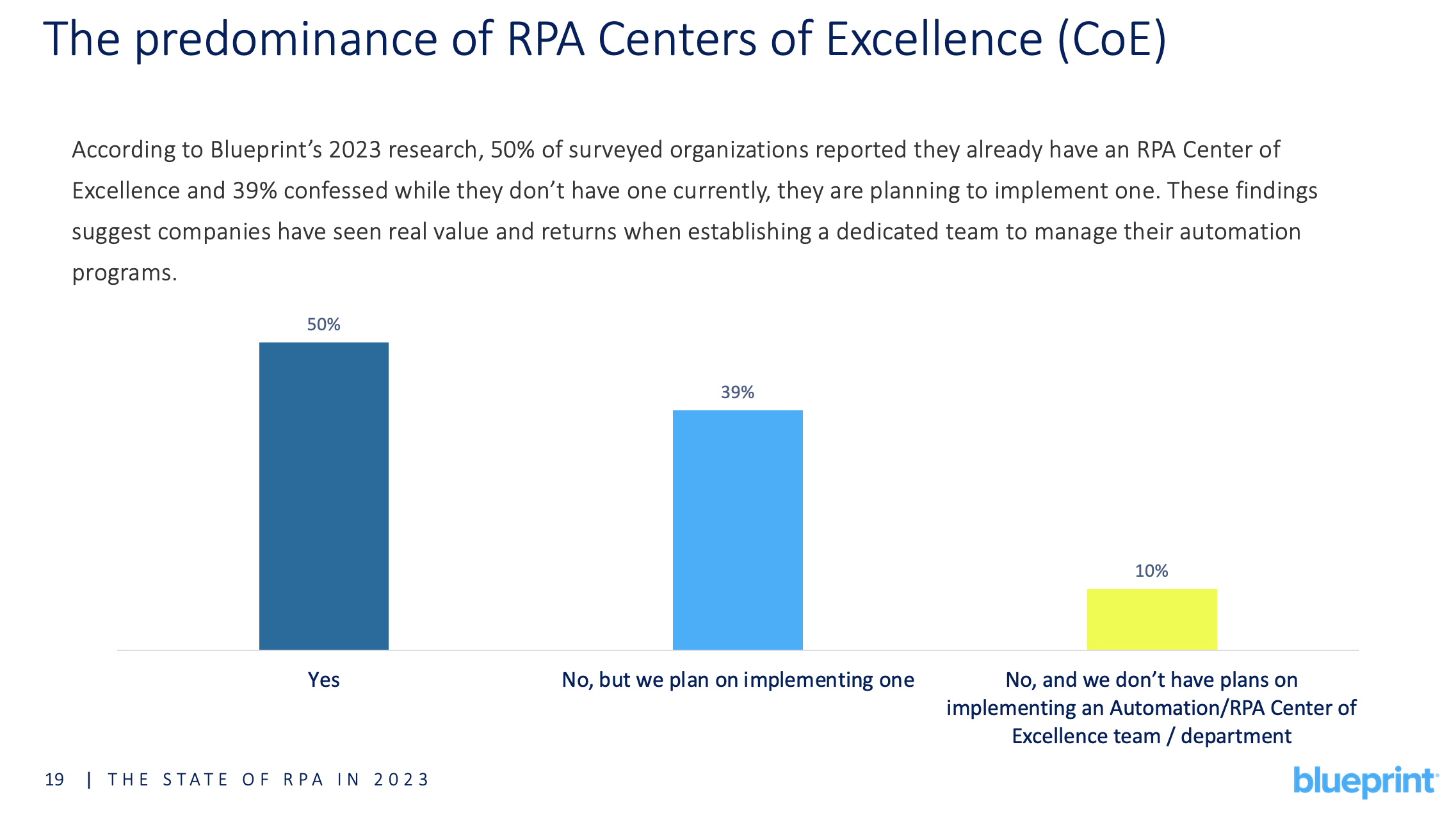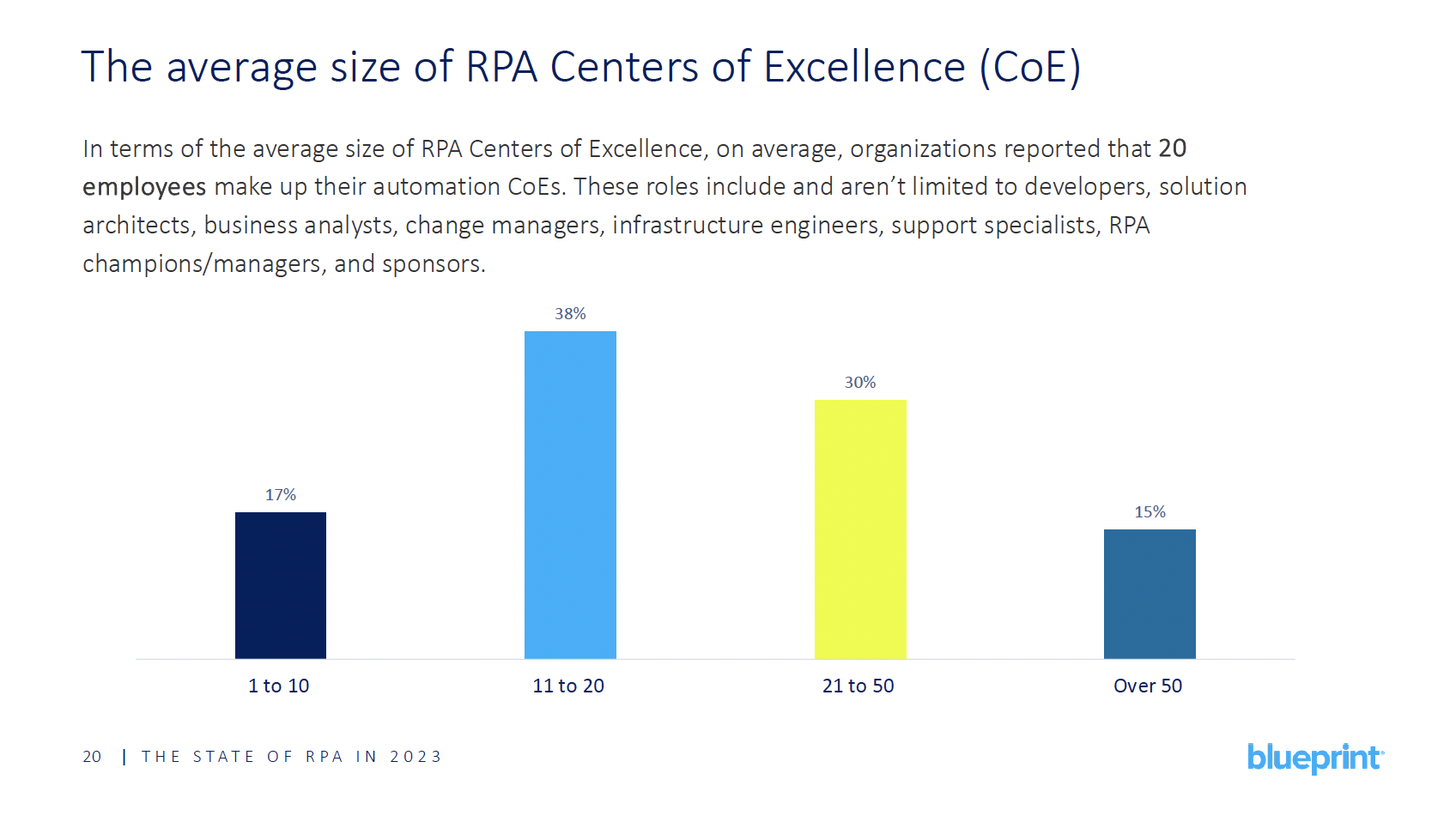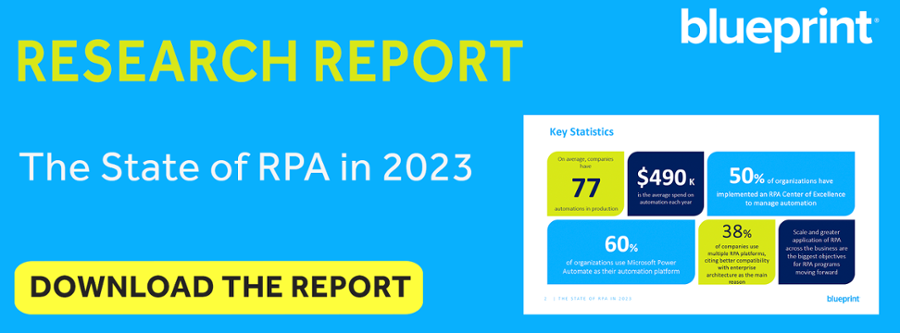An Insider’s Look at RPA Centers of Excellence (CoE) in 2023
The benefits RPA (robotic process automation) Centers of Excellence (CoE) deliver are clear. They enable automation at scale, standardization, continuous learning to improve quality and output, and improve automation governance.
Even with all the value RPA Centers of Excellence deliver, it’s difficult to find information on how many organizations have implemented a CoE in their automation practice and how big their Centers of Excellence actually are.
Earlier this year, Blueprint conducted research to understand the state of automation practices globally. Part of that research was designed to uncover the predominance of RPA Centers of Excellence and understand how big they typically are. Here’s what we found.
How Common are RPA Centers of Excellence?
RPA Centers of Excellence have long been regarded as the optimal form of automation management and governance. Yet even with this common knowledge, only 50% of organizations have set up and implemented an RPA CoE to run their automation practice, according to Blueprint’s research.

While 50% have an established, centralized team to manage their automation program, almost 40% report that they plan on implementing one. A lowly 10% reported that there were no plans in the pipeline to set up and implement an RPA CoE.
These findings suggest a few things:
Firstly, the fact that 50% of organizations already have a CoE in place and nearly 40% have plans to set one up suggests there is real value and significant benefits to be realized by implementing a dedicated automation team.
The 10% percent that deems an RPA Center of Excellence surplus to requirements could be attributed to several logical reasons. They could be in a place in their automation journey that doesn’t warrant a centralized or federated CoE as a governance model. Their automation estate could still be in its infancy and small, thereby not requiring a robust team to scale and accelerate automation delivery. Even if that’s the case, if the business is keen to increase its application of automation, an RPA CoE will be needed, and that team will need to scale as you will see in the next section.
How Big are RPA Centers of Excellence Typically?
Their responses differed when asking those organizations that reported they already had RPA Centers of Excellence in place how big their CoEs were.
According to Blueprint's research, the average size of RPA CoEs was 20 employees. Yet 15% reported that their CoE consisted of 50 employees or more. Most organizations that reported having the largest RPA CoEs were predominantly enterprises with 10,000+ employees.

22% of organizations with 10,000+ employees reported that their CoEs were made up of at least 50 team members or more. Considering the size of these enterprises, it’s a natural phenomenon that their teams that manage automation across the business are the largest. The size of their RPA CoE needs to match the size of their automation estates and objectives for wider application and scale.
An RPA Center of Excellence at a larger enterprise would most likely consist of the following roles and team members:
- RPA Sponsor - establishes RPA as an enterprise-wide strategic priority.
- RPA Champion - leads the operational management of the digital workforce.
- RPA Business Analyst - the business process SME (subject matter expert) responsible for identifying automation opportunities, prioritizing them, and creating process definitions and maps for automation.
- RPA Solution Architect – defines the automation architecture and oversees it from end to end.
- RPA Change Manager – ensures the implementation of RPA within the organization is easy and scalable. It’s their job to create the change and communication plan that is aligned with organizational objectives.
- RPA Infrastructure Engineer – responsible for the infrastructure support for server installation and troubleshooting.
- RPA Supervisor - manages, orchestrates, and controls the digital workforce as part of the operational environment.
- RPA Developer – the RPA or automation engineer responsible for developing, testing, and supporting the implementation of automated processes.
- RPA Service Support – the first line of assistance for the RPA solution when in deployment.
Conversely, smaller organizations with 499-1000 employees reported the largest proportion of smaller RPA Centers of Excellence, ranging from 1-10 people. Again, this is a logical occurrence since the automation estates at these organizations will most likely be smaller and demand a lighter CoE to manage and maintain them.
In conclusion, although there are abundant and attractive benefits in establishing RPA Centers of Excellence, only 50% of organizations have taken concrete steps to implement them. While the other 50% remain without an RPA CoE, nearly 40% plan to establish them to manage their automation practices.
The size of the average RPA Center of Excellence is 20 employees. Sizeable enterprises with bigger RPA estates will naturally have larger RPA CoEs with 50+ employees in some cases, whereas small- to mid-sized businesses tend to have smaller CoEs made up of 1-10 people.
Discover more on RPA governance in 2023 in addition to the sizes of RPA estates, total cost of ownership, RPA infrastructure, and the objectives for the future RPA leaders have defined by downloading Blueprint's State of RPA in 2023 research report.
Share this
Recent Stories

Why Workflow Automation Projects Fail (and How to Get Them Back on Track)

Why Process Design Documents (PDD) Limit RPA at Scale



.png)

